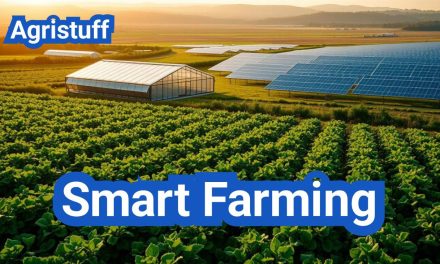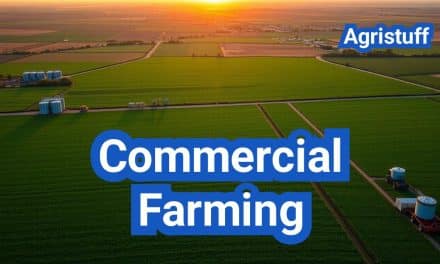The term agribusiness encompasses the economic sectors related to farming and farming-related commerce. It involves the production, processing, and distribution of farm-based goods, playing a crucial role in the global economy.
Agricultural business and management are critical components of agribusiness, requiring effective strategies to navigate the challenges faced by the sector. From crop production to market distribution, agribusiness is a complex and multifaceted industry.
Key Takeaways
- Agribusiness includes farming and related commerce.
- It involves production, processing, and distribution.
- Effective management is crucial for success.
- The sector faces various challenges.
- Understanding agribusiness is essential for stakeholders.
What is Agribusiness?
The term ‘agribusiness’ encompasses a broad range of activities related to the production, processing, and distribution of agricultural products. It represents a significant evolution in how food and other agricultural commodities are produced, processed, and brought to market.
Definition and Scope of Agricultural Business
Agribusiness refers to the business side of farming, including everything from growing crops to processing food. It involves the application of advanced technologies and management practices to improve efficiency and productivity. As Dr. John Smith, an agricultural economist, notes, “Agribusiness is not just about farming; it’s about creating a sustainable and profitable business model that meets the demands of a growing global population.”
The scope of agribusiness is vast, encompassing various sectors such as crop production, livestock farming, agricultural equipment manufacturing, and food processing. It also includes service providers like agricultural consultants, financial institutions, and logistics companies that support the agricultural industry.
The Difference Between Traditional Farming and Agribusiness
Traditional farming typically focuses on the production aspect, with farmers growing crops or raising livestock using conventional methods. In contrast, agribusiness takes a more holistic approach, integrating production with processing, marketing, and distribution. As
“The future of farming is not just about growing crops, it’s about growing a business,”
says
Jane Doe, CEO of Green Earth Farms
.
Modern agribusiness incorporates advanced technologies such as precision agriculture, biotechnology, and data analytics to enhance productivity and efficiency. It also involves sophisticated management practices, including strategic planning, market analysis, and financial management.
By adopting a business-oriented approach, agribusinesses can better respond to market demands, manage risks, and improve their overall competitiveness in the global market.
The Evolution of Modern Agribusiness

The evolution of agribusiness has been marked by significant milestones, from the introduction of mechanized farming equipment to the adoption of precision agriculture techniques. This transformation has not only increased efficiency but also improved productivity, enabling the industry to meet the growing demands of a global population.
Historical Development of Agricultural Commerce
The history of agribusiness is deeply rooted in traditional farming practices. Over time, these practices have evolved significantly, driven by technological innovations and changing consumer preferences. The introduction of mechanized farming tools in the 19th century marked one of the earliest significant advancements, allowing for larger areas to be cultivated with less manual labor.
The 20th century saw further transformations with the advent of chemical fertilizers and pesticides, which greatly increased crop yields. However, these practices also had environmental impacts, leading to a shift towards more sustainable methods in recent years.
Current Trends Shaping the Industry
Today, agribusiness is characterized by the integration of technology and data analysis to optimize production. Precision agriculture, which involves the use of GPS, sensors, and drones to monitor and manage crops, is becoming increasingly prevalent. This approach not only enhances efficiency but also reduces environmental impact by minimizing the use of resources such as water and fertilizers.
Another significant trend is the growing demand for sustainable and organic products. Consumers are becoming more conscious of the environmental and social implications of their purchasing decisions, driving the industry towards more eco-friendly practices.
- Increased use of technology and data analytics
- Growing demand for sustainable and organic products
- Expansion of vertical farming and urban agriculture
As the agribusiness sector continues to evolve, it is likely that we will see further innovations in technology and production methods, as well as a continued shift towards sustainability.
Types of Agribusiness Ventures
Agribusiness ventures are categorized into several types based on their functions and services within the agricultural value chain. These categories are crucial for understanding the diverse landscape of the agribusiness sector.
Production-Based Ventures
Production-based ventures are at the core of agribusiness, involving the cultivation, breeding, and harvesting of crops and livestock. These ventures are fundamental to the supply chain, providing the raw materials that are processed and consumed. Examples include:
- Agricultural Crop Production: Growing crops such as corn, soybeans, and wheat.
- Livestock Production: Raising cattle, poultry, and swine for meat and dairy products.
- Aquaculture: Farming fish, shrimp, and other seafood.
These production-based ventures are critical for food security and are influenced by factors such as climate, technology, and market demand.
Service-Based Agricultural Businesses
Service-based agricultural businesses provide essential support to production-based ventures. They offer a range of services that enhance efficiency and productivity in the agricultural sector. Key examples include:
- Agricultural Consulting: Providing expertise on best practices, soil management, and crop rotation.
- Farm Equipment Maintenance: Repair and maintenance services for tractors, harvesters, and other machinery.
- Veterinary Services: Healthcare services for livestock, including vaccinations and disease management.
These services are vital for the smooth operation of agricultural enterprises, helping to mitigate risks and improve yields.
Support Sector Agribusiness
The support sector in agribusiness encompasses businesses that provide goods and services necessary for the operation of agricultural ventures. This includes:
- Agricultural Inputs: Suppliers of seeds, fertilizers, pesticides, and other essential inputs.
- Logistics and Distribution: Companies that handle the transportation, storage, and distribution of agricultural products.
- Financial Services: Banks, insurance companies, and other financial institutions that provide capital and risk management products to agribusinesses.
These support sector businesses are integral to the agribusiness ecosystem, facilitating the flow of goods, services, and capital.
The Agribusiness System and Value Chain

Understanding the agribusiness system is crucial for navigating the agricultural industry’s intricacies. The agribusiness system is a multifaceted network that encompasses various stakeholders and activities working in tandem to produce and distribute agricultural products.
Components of the Agribusiness System
The agribusiness system consists of several key components, including input supply, production, processing, and distribution. The input supply sector is vital as it provides the necessary materials for agricultural production.
Companies like Monsanto and DuPont Pioneer are well-known for their high-quality seeds and agricultural chemicals.
Understanding Agricultural Value Chains
An agricultural value chain refers to the series of activities involved in bringing a product from its raw state to the end consumer. This includes production, processing, packaging, distribution, and retail.
Value chains are crucial because they help identify areas where value can be added or costs can be reduced. For instance, improving logistics can reduce transit times and costs, making a product more competitive.
| Stage | Activity | Stakeholders Involved |
|---|---|---|
| Input Supply | Production of seeds and fertilizers | AgChem Inc., SeedCorp |
| Production | Cultivation of crops | Farmers, Agricultural Cooperatives |
| Processing | Transformation into consumable goods | Processing Companies, Food Manufacturers |
| Distribution | Logistics and retail | Wholesalers, Retailers, Logistics Providers |
In conclusion, the agribusiness system and agricultural value chains are interconnected concepts that are vital for the efficient production and distribution of agricultural products. By understanding these components and how they interact, businesses can identify opportunities to add value and reduce costs.
Food Supply Chain Management in Agribusiness
The agribusiness sector relies heavily on robust food supply chain management to deliver fresh produce to consumers in a timely manner. Effective supply chain management ensures that products move efficiently from farms to consumers, maintaining quality and reducing waste.
Structure of Agricultural Supply Chains
Agricultural supply chains are complex networks involving multiple stakeholders, including farmers, processors, distributors, and retailers. Efficient supply chain management is crucial for coordinating these stakeholders and ensuring the smooth flow of products.
- Farmers: Produce agricultural products.
- Processors: Transform raw products into consumable goods.
- Distributors: Transport products to various locations.
- Retailers: Sell products directly to consumers.
Distribution Networks and Logistics
Distribution networks and logistics play a vital role in the timely delivery of fresh produce. Advanced logistics solutions, such as refrigerated transportation and real-time tracking, help maintain product quality and reduce spoilage.
“The future of food supply chains lies in their ability to adapt to changing consumer demands and technological advancements.” – Industry Expert
Retail and Consumer Interfaces
The interface between retailers and consumers is critical in the food supply chain. Retailers must ensure that products are fresh, available, and presented attractively to consumers. Consumer preferences are increasingly influencing supply chain management practices, with a growing demand for sustainable and traceable products.
By understanding and optimizing each component of the food supply chain, agribusinesses can improve efficiency, reduce costs, and enhance customer satisfaction. As the industry continues to evolve, the importance of effective food supply chain management will only continue to grow.
Examples of Successful Agribusiness Models

From large-scale corporations to innovative startups, the agribusiness landscape is diverse and dynamic. Successful agribusiness models can be found in various forms, each addressing different aspects of the agricultural value chain.
Large-Scale Agribusiness Companies
Large-scale agribusiness companies have made significant impacts on the global food system. These corporations often have extensive resources to invest in technology, infrastructure, and human capital. For instance, companies like Cargill and Archer Daniels Midland (ADM) are leaders in the global agribusiness sector, operating across multiple countries and commodity markets.
These large-scale companies have achieved success through:
- Economies of scale in production and distribution
- Advanced supply chain management
- Diversification of products and services
| Company | Revenue (Billion USD) | Primary Commodities |
|---|---|---|
| Cargill | 114.6 | Grains, oilseeds, corn |
| Archer Daniels Midland | 64.3 | Cocoa, corn, soybeans |
Small and Medium Agricultural Enterprises
Small and medium agricultural enterprises (SMAEs) play a crucial role in local food systems and rural economies. These businesses often focus on niche markets and can be highly innovative in their approaches to production and marketing.
SMAEs achieve success by:
- Offering unique or specialty products
- Engaging directly with local consumers
- Adapting quickly to changing market conditions
Innovative Agribusiness Startups
Agribusiness startups are driving innovation in the sector, leveraging technologies such as precision agriculture, biotechnology, and digital platforms to improve efficiency and sustainability.
Examples of innovative startups include those focused on:
- Precision farming technologies
- Alternative proteins and plant-based foods
- Digital marketplaces for farmers
These startups often face challenges such as scaling their operations and navigating regulatory environments, but they have the potential to significantly impact the future of agribusiness.
Agribusiness Management Fundamentals

To thrive in the competitive agricultural sector, businesses must master agribusiness management fundamentals. Effective management is critical for the success of agribusinesses, involving strategic planning, resource allocation, and optimization of operations.
Key Management Principles for Agricultural Businesses
Successful agribusiness management hinges on several key principles. These include:
- Strategic Planning: Developing a clear business strategy that aligns with market demands and company capabilities.
- Operational Efficiency: Streamlining processes to reduce waste and improve productivity.
- Risk Management: Identifying and mitigating risks associated with agricultural production and market fluctuations.
By focusing on these principles, agribusinesses can enhance their competitiveness and profitability.
Resource Allocation and Optimization
Effective resource allocation is vital for maximizing returns on investment in agribusiness. This involves:
- Assessing available resources, including land, labor, and capital.
- Allocating resources based on strategic priorities and operational needs.
- Implementing optimization techniques to improve resource utilization efficiency.
Resource optimization can lead to significant cost savings and improved productivity. For instance, precision agriculture techniques can help farmers optimize the use of water, fertilizers, and pesticides.
| Resource | Optimization Technique | Potential Benefit |
|---|---|---|
| Water | Drip irrigation | Reduced water consumption |
| Fertilizers | Precision application | Increased crop yield |
| Labor | Mechanization | Reduced labor costs |
By adopting these strategies, agribusinesses can achieve a competitive edge in the market. Effective agribusiness management is not just about maximizing profits; it’s also about ensuring sustainability and long-term viability.
Step1: Assessing Your Readiness for Agribusiness

Assessing your readiness is a critical first step in starting a successful agribusiness. This initial step involves a comprehensive evaluation of various factors that can significantly impact your venture’s success.
Evaluating Your Agricultural Knowledge Base
Having a solid understanding of agricultural practices, crop management, and livestock care is fundamental to running a successful agribusiness. It’s essential to assess your knowledge in these areas and identify any gaps that may need to be addressed through training or hiring experienced staff.
Agricultural Knowledge Assessment Checklist:
- Crop rotation and soil management
- Irrigation systems and water conservation
- Pest management and crop protection
- Livestock health and nutrition
- Farm equipment maintenance
Analyzing Your Financial Capacity
Starting and maintaining an agribusiness requires significant financial investment. It’s crucial to analyze your financial capacity, including your available capital, potential funding sources, and projected expenses.
| Financial Component | Description | Estimated Cost |
|---|---|---|
| Initial Investment | Land preparation, equipment, and initial operational costs | $100,000 – $500,000 |
| Ongoing Expenses | Seeds, fertilizers, labor, and equipment maintenance | $50,000 – $200,000 per year |
| Contingency Fund | Emergency funds for unexpected expenses or crop failures | $20,000 – $100,000 |
Determining Your Market Entry Strategy
Understanding your target market and developing an effective market entry strategy are vital for the success of your agribusiness. This involves identifying your target customers, analyzing competitors, and determining the best channels for marketing and distribution.
Market Entry Strategy Considerations:
- Identify target customer segments
- Analyze competitor strengths and weaknesses
- Develop a unique selling proposition (USP)
- Choose appropriate marketing channels
- Establish a distribution network
By carefully evaluating your agricultural knowledge, financial capacity, and market entry strategy, you can better assess your readiness to start a successful agribusiness.
Step2: Conducting Thorough Market Research

To navigate the complex landscape of agribusiness, entrepreneurs must first undertake comprehensive market research. This critical step enables businesses to understand the intricacies of their target market, identify potential opportunities, and develop strategies to compete effectively.
Identifying Viable Market Opportunities
Identifying viable market opportunities is a crucial aspect of market research in agribusiness. This involves analyzing consumer demand, market trends, and the competitive landscape to pinpoint areas where a business can establish a strong presence.
- Analyze consumer demand for specific agricultural products.
- Examine market trends, including shifts towards sustainable or organic products.
- Assess the competitive landscape to identify gaps in the market.
Analyzing Existing Competition
Analyzing existing competition is another vital component of market research. By understanding who the competitors are, what strategies they employ, and how they are perceived by consumers, agribusinesses can differentiate themselves and carve out their own niche in the market.
Key factors to consider when analyzing competition include:
- Market share and positioning.
- Pricing strategies and product offerings.
- Marketing and distribution channels.
Researching Consumer Preferences and Trends
Researching consumer preferences and trends is essential for developing products and services that meet the evolving needs of the market. This involves staying abreast of changes in consumer behavior, preferences, and expectations.
Some of the key trends to watch include:
- Increasing demand for sustainable and environmentally friendly products.
- Growing interest in health and wellness, driving demand for organic produce.
- Technological advancements influencing production and distribution methods.
By conducting thorough market research, agribusiness entrepreneurs can make informed decisions, reduce the risk of market entry, and increase their chances of success in a competitive and ever-evolving industry.
Step3: Developing a Comprehensive Agribusiness Plan

Creating a detailed agribusiness plan is essential for navigating the complexities of modern agriculture. This plan serves as a roadmap, guiding entrepreneurs through the various stages of their business, from startup to maturity.
Creating Your Business Model and Strategy
The first step in developing an agribusiness plan is to create a robust business model and strategy. This involves defining your mission, identifying target markets, and determining the products or services you will offer. A well-defined business model helps in understanding the operational requirements and revenue streams of your agribusiness.
Key components of a business model include:
- Value proposition
- Customer segments
- Channels
- Customer relationships
- Revenue streams
- Key resources
- Key activities
- Key partnerships
- Cost structure
Establishing Financial Projections and Funding Sources
Financial planning is a critical aspect of your agribusiness plan. This involves creating detailed financial projections, including income statements, balance sheets, and cash flow statements. Accurate financial projections help in securing funding and making informed business decisions.
To establish reliable financial projections, consider:
- Historical data from similar businesses
- Market research and trends
- Operational costs and capital expenditures
- Potential revenue streams
Implementing Risk Assessment and Mitigation Strategies
Every agribusiness faces various risks, including market volatility, climate change, and regulatory compliance. A comprehensive agribusiness plan must include risk assessment and mitigation strategies to ensure business resilience.
Effective risk mitigation involves:
- Identifying potential risks
- Assessing the impact of these risks
- Developing strategies to mitigate or manage these risks
- Monitoring and reviewing risk management plans regularly
By following these steps and creating a comprehensive agribusiness plan, entrepreneurs can better navigate the challenges of the agricultural sector and achieve long-term success.
Step4: Navigating Legal Requirements and Regulations

Understanding and adhering to legal requirements is essential for the longevity of agribusiness ventures. Agribusinesses operate within a complex legal framework that varies by country, state, and even local jurisdictions. Compliance with these regulations is not only mandatory but also crucial for maintaining a positive reputation and avoiding legal repercussions.
Obtaining Necessary Permits and Licenses
One of the initial steps in establishing an agribusiness is obtaining the necessary permits and licenses. These legal documents grant permission to operate and ensure that the business meets minimum standards set by regulatory bodies. The types of permits required can vary widely depending on the nature of the agribusiness, ranging from water usage permits to permits for handling specific types of agricultural products.
Key permits and licenses include:
- Business operation license
- Environmental permits
- Health department permits
- Permits for handling and storing agricultural chemicals
Ensuring Environmental Compliance
Agribusinesses have a significant impact on the environment, making environmental compliance a critical aspect of their operations. Regulations are in place to protect natural resources, including water and soil, and to ensure sustainable practices. Compliance involves implementing practices that minimize environmental impact, such as efficient irrigation systems and responsible waste management.
Environmental compliance also involves regular monitoring and reporting to ensure that agribusinesses adhere to environmental standards. This can include maintaining records of water usage, soil testing, and waste disposal practices.
| Environmental Aspect | Regulatory Requirement | Compliance Measure |
|---|---|---|
| Water Usage | Water conservation regulations | Efficient irrigation systems |
| Soil Quality | Soil conservation practices | Crop rotation and cover cropping |
| Waste Management | Proper disposal of agricultural waste | Composting and recycling programs |
Meeting Food Safety Standards and Certifications
For agribusinesses involved in food production, meeting food safety standards is paramount. This involves adhering to regulations that govern the handling, processing, and distribution of food products. Certifications such as Good Agricultural Practices (GAP) and Hazard Analysis and Critical Control Points (HACCP) are recognized standards that demonstrate a commitment to food safety.
Steps to achieve food safety certifications include:
- Implementing sanitation and hygiene practices
- Conducting regular audits and inspections
- Training staff on food safety protocols
By navigating legal requirements and regulations effectively, agribusinesses can ensure compliance, reduce risks, and contribute to a sustainable and safe food system.
Technology in Modern Agribusiness
The agribusiness landscape is being reshaped by the adoption of cutting-edge technologies and digital tools, driving growth, sustainability, and efficiency in the agricultural sector.
AgTech Solutions Transforming the Industry
AgTech, or agricultural technology, encompasses a broad range of innovations designed to improve farming practices, enhance crop yields, and reduce environmental impact. Precision agriculture, enabled by technologies like GPS, drones, and satellite imaging, allows farmers to make data-driven decisions, optimizing resource allocation and minimizing waste.
Another significant AgTech trend is the use of artificial intelligence (AI) and machine learning (ML) to analyze data from various sources, predict crop health, and detect potential issues before they become major problems.
Smart Agriculture and Precision Farming
Smart agriculture integrates advanced technologies into farming practices to increase efficiency and productivity. Precision farming techniques, such as precision irrigation and crop monitoring, enable farmers to tailor their practices to specific field conditions, reducing the overuse of resources and minimizing environmental impact.
The use of Internet of Things (IoT) devices in smart agriculture allows for real-time monitoring of soil moisture, temperature, and other critical factors, enabling farmers to make timely interventions.
Digital Tools for Agribusiness Management
Digital tools are revolutionizing agribusiness management by providing farmers and agricultural businesses with the ability to track, analyze, and optimize their operations. Farm management software enables the planning, execution, and monitoring of farming activities, while also facilitating compliance with regulatory requirements.
Blockchain technology is being explored for its potential to enhance supply chain transparency and traceability, ensuring the authenticity and quality of agricultural products.
Careers and Opportunities in Agribusiness

With its unique blend of agriculture and business, agribusiness presents numerous career paths for individuals with various skills and interests. The sector encompasses a broad range of opportunities, from traditional farming and production to management, technology, and entrepreneurship.
Educational Pathways to Agribusiness Careers
Pursuing a career in agribusiness often begins with acquiring the right education. Various academic programs and courses can prepare individuals for the diverse roles within the industry. Some of the key educational pathways include:
- Degree programs in agricultural sciences, business management, and related fields
- Specialized courses in agricultural technology, precision farming, and agribusiness management
- Certification programs that focus on specific aspects of agribusiness, such as sustainable practices or agricultural finance
These educational pathways not only provide foundational knowledge but also equip individuals with the skills necessary to succeed in the agribusiness sector.
Job Roles and Specializations
Agribusiness encompasses a wide array of job roles and specializations. Some of the key areas include:
- Production and Operations: Roles related to farming, livestock management, and crop production.
- Management and Administration: Positions that involve overseeing business operations, financial management, and human resources.
- Marketing and Sales: Careers focused on promoting and selling agricultural products.
- Research and Development: Opportunities in agricultural research, technology development, and innovation.
These roles require a range of skills, from technical knowledge of agriculture to business acumen and marketing expertise.
Entrepreneurial Opportunities in the Agricultural Sector
Agribusiness also offers numerous entrepreneurial opportunities for those looking to start their own ventures. With the growing demand for sustainable and innovative agricultural practices, entrepreneurs can capitalize on trends such as:
- Organic and specialty crop production
- Agricultural technology and precision farming
- Sustainable farming practices and eco-friendly products
- Agritourism and farm-based experiences
By identifying niche markets and leveraging their expertise, entrepreneurs can establish successful businesses within the agribusiness sector.
Challenges Facing Modern Agribusiness
Contemporary agribusiness is beset by various challenges that threaten its viability and future prospects. The sector faces a complex interplay of factors that can impact its sustainability and profitability.
Climate Change and Environmental Pressures
One of the most significant challenges is climate change, which affects agricultural productivity and stability. Rising temperatures, changing precipitation patterns, and increased frequency of extreme weather events can lead to crop failures, reduced yields, and changed growing seasons. Agribusinesses must adapt to these environmental pressures by implementing sustainable practices and developing climate-resilient crops.
Market Volatility and Price Fluctuations
Agribusinesses are also exposed to market volatility and price fluctuations. Factors such as global demand, trade policies, and currency exchange rates can influence market prices. To mitigate these risks, agribusinesses can engage in market analysis and adopt hedging strategies to stabilize their revenues.
Labor and Resource Constraints
Labor shortages and resource constraints pose another challenge to agribusinesses. The sector often struggles to attract and retain skilled labor, particularly during peak seasons. Additionally, the increasing cost of inputs such as water, seeds, and fertilizers can strain resources. Agribusinesses can address these challenges by investing in automation technologies and optimizing their resource allocation.
Regulatory Compliance Challenges
Finally, agribusinesses must navigate a complex landscape of regulations and compliance requirements. This includes adhering to food safety standards, environmental regulations, and labor laws. To ensure compliance, agribusinesses should implement robust management systems and stay informed about changing regulatory requirements.
Finally: The Future of Agribusiness
The future of agribusiness is poised to be shaped by technological innovations, evolving consumer preferences, and the imperative for sustainable practices. As the global population continues to grow, the agribusiness sector must adapt to meet the increasing demand for food while minimizing its environmental footprint.
Emerging agribusiness trends include the adoption of precision farming techniques, the integration of digital tools for farm management, and the rise of sustainable agribusiness practices. These trends are expected to drive growth and profitability in the sector while promoting environmental stewardship.
The importance of sustainable agribusiness cannot be overstated. As consumers become more environmentally conscious, businesses that prioritize sustainability are likely to gain a competitive edge. The future of agribusiness will be characterized by a heightened focus on eco-friendly practices, reduced waste, and efficient resource allocation.
By embracing innovation and sustainability, agribusinesses can not only ensure their long-term viability but also contribute to a more food-secure future. As the industry continues to evolve, it is essential for stakeholders to stay informed about the latest developments and best practices in agribusiness trends and sustainable agriculture.
FAQ
What is agribusiness, and how does it differ from traditional farming?
Agribusiness refers to the business side of agriculture, encompassing all activities related to the production, processing, and distribution of agricultural products. It differs from traditional farming in its focus on commercial aspects, incorporating advanced technologies and management techniques to improve efficiency and productivity.
What are the main categories of agribusiness ventures?
Agribusiness ventures can be categorized into three main types: production-based, service-based, and support sector. Production-based ventures involve the actual production of agricultural products, while service-based businesses provide services such as consulting, machinery operation, and logistics. Support sector agribusinesses supply inputs like seeds, fertilizers, and equipment.
How has technology impacted modern agribusiness?
Technology has transformed modern agribusiness through AgTech innovations, smart agriculture practices, and digital tools. These advancements have improved crop yields, reduced waste, and enhanced operational efficiency. Examples include precision farming, drones, and data analytics.
What are the key challenges facing modern agribusiness?
Modern agribusiness faces several challenges, including climate change, market volatility, labor and resource constraints, and regulatory compliance. Climate change affects crop yields and farming conditions, while market volatility impacts prices and profitability. Labor shortages and resource constraints can hinder production, and regulatory compliance requires adherence to various laws and standards.
How can individuals assess their readiness to start an agribusiness?
To assess readiness, individuals should evaluate their agricultural knowledge, analyze their financial capacity, and determine their market entry strategy. This involves understanding the production and business aspects of agriculture, assessing available capital, and identifying a viable market opportunity.
What is the importance of market research in agribusiness?
Market research is crucial in agribusiness as it helps identify viable market opportunities, analyze existing competition, and understand consumer preferences and trends. This information enables businesses to develop effective strategies, differentiate themselves, and meet market demands.
What are the essential components of a comprehensive agribusiness plan?
A comprehensive agribusiness plan should include a business model, financial projections, funding sources, and risk assessment and mitigation strategies. It should outline the business’s mission, objectives, and strategies, as well as financial plans, funding requirements, and contingency plans for potential risks.
What are the career opportunities available in agribusiness?
Agribusiness offers various career paths, including roles in production, processing, marketing, and management. Educational pathways range from agricultural degrees to business and management courses. Specializations include agricultural economics, agribusiness management, and agricultural technology.
How do agricultural value chains work?
Agricultural value chains refer to the series of activities involved in the production, processing, and distribution of agricultural products. They encompass all stages from input supply to final consumption, involving various stakeholders and requiring coordination and management to ensure efficiency and profitability.
What is the role of distribution networks and logistics in agribusiness?
Distribution networks and logistics play a critical role in agribusiness, ensuring that products reach consumers efficiently. This involves managing transportation, storage, and inventory, as well as coordinating with retailers and other stakeholders to meet consumer demands.
Conclusion of: Agribusiness
Agribusiness plays a critical role in global food systems, rural development, and economic stability. From farm operations to food distribution, agribusiness encompasses all the business activities involved in agricultural production. In this comprehensive guide, we’ll explore what agribusiness is, its components, challenges, opportunities, and innovations shaping its future.
What Is Agribusiness?
Agribusiness refers to the industries, organizations, and operations that are involved in the production, processing, and distribution of agricultural goods. This includes farming, seed supply, agrichemicals, machinery, distribution, and retail sales. Agribusiness serves as the bridge between agricultural production and consumers.
Agribusiness goes beyond farming—it integrates business strategies and technologies to maximize profitability and sustainability in food production. Its importance continues to grow as global food demand increases.
Components of Agribusiness
The agribusiness ecosystem includes a wide range of sectors:
- Input suppliers (fertilizers, seeds, irrigation)
- Farm producers
- Processing units
- Storage and logistics
- Retail and export operations
Each component in agribusiness is interconnected. For example, advancements in agricultural technology directly impact production efficiency and profitability, influencing the entire supply chain.
Explore global agribusiness structure from FAO
Agribusiness vs. Traditional Farming
While traditional farming focuses solely on crop or livestock production, agribusiness involves an integrated chain of operations. It includes:
- Strategic planning
- Marketing and branding
- Risk management
- Financial investments
Agribusiness aims to treat agriculture like a business, optimizing operations from soil to supermarket shelf.
Comparison guide from Harvard Business School
The Economic Importance of Agribusiness
Agribusiness contributes significantly to the GDP of many countries, especially in developing and agricultural economies. In the U.S., agribusiness contributes over $1 trillion annually, supporting millions of jobs across sectors like food manufacturing, logistics, and retail.
By generating employment and contributing to exports, agribusiness becomes a backbone for national economies.
U.S. Department of Agriculture (USDA) stats
Modern Agribusiness Technologies
Today’s agribusiness heavily relies on agtech innovations like:
- Precision agriculture
- Drone monitoring
- AI-powered analytics
- IoT-based irrigation systems
These technologies help reduce waste, improve yields, and enhance supply chain transparency, thus transforming traditional farming into smart agribusiness operations.
Sustainability in Agribusiness
Sustainability is a growing priority in agribusiness. With climate change and soil degradation threatening global food security, many agribusinesses are shifting to:
- Organic farming
- Water-efficient irrigation
- Renewable energy-powered farms
- Sustainable supply chains
Consumers also demand transparency and eco-friendly practices, pushing agribusinesses to adapt.
Read more from Sustainable Agriculture Research & Education (SARE)
Agribusiness and Global Trade
Agribusiness is a cornerstone of international trade. From soybeans to coffee and beef, many countries rely on exports of agricultural goods. Trade policies, tariffs, and international standards significantly impact agribusiness profitability.
U.S. agribusiness exports, for example, reached over $196 billion in 2022, showcasing its critical role in global markets.
Global trade overview from WTO
Agribusiness Challenges
Despite its potential, agribusiness faces several challenges:
- Climate variability
- Labor shortages
- Supply chain disruptions
- Market volatility
- Policy and regulatory constraints
Navigating these issues requires strategic planning, government support, and innovation to sustain profitability.
Detailed insight from McKinsey & Company
Agribusiness and Climate Change
The relationship between agribusiness and climate change is two-fold. On one hand, agriculture contributes to emissions; on the other, it is highly vulnerable to environmental changes.
Leading agribusinesses are now investing in carbon-smart agriculture, regenerative practices, and emission-tracking systems to reduce their environmental footprint.
Climate-smart agriculture explained by World Bank
Opportunities in Agribusiness
Agribusiness offers massive career and investment opportunities:
- Entrepreneurship in value-added products
- Vertical farming and indoor agriculture
- Agricultural finance and insurance
- Agri-tourism and farm branding
From investors to students and policy-makers, the agribusiness landscape offers diverse entry points.
Career insights from AgCareers
Agribusiness and Food Security
Food security remains a global concern, and agribusiness plays a pivotal role in addressing it. By ensuring efficient production, minimizing post-harvest losses, and enabling distribution, agribusiness strengthens national and global food systems.
Especially in regions like Africa and Southeast Asia, agribusiness can empower local economies and reduce hunger.
Food security resources from IFPRI
Government and Policy in Agribusiness
Government policies play a massive role in shaping agribusiness outcomes. From subsidies and tax incentives to export regulations and research grants, public policies determine profitability and risk.
Effective agribusiness strategies must align with both domestic and international agricultural policies.
Policy brief from OECD Agriculture
Agribusiness Education and Research
Top universities now offer degrees in agribusiness management, integrating agriculture with economics, data analytics, and marketing. Research institutions are also driving innovation in areas such as:
- Supply chain optimization
- Pest-resistant crop varieties
- Agri-fintech solutions
This academic push is preparing the next generation of agribusiness leaders.
See agribusiness programs at Purdue University
Final Thought
Agribusiness is more than farming—it’s a complex, evolving, and essential part of the global economy. As technology, climate change, and consumer preferences reshape agriculture, agribusiness stands at the forefront of delivering sustainable, profitable, and innovative solutions. Whether you’re a farmer, entrepreneur, policymaker, or consumer, agribusiness impacts your life in countless ways. Investing in smarter and more sustainable agribusiness is no longer optional—it’s the future of food and farming.










